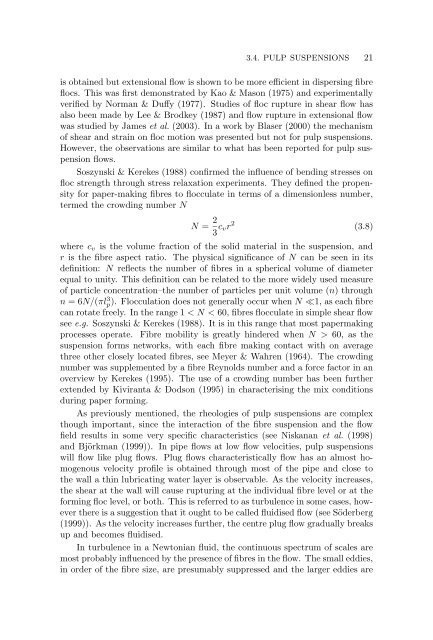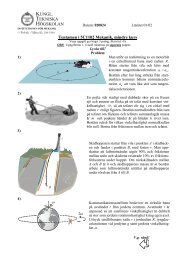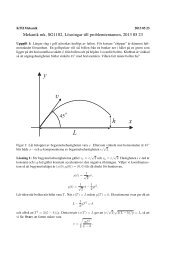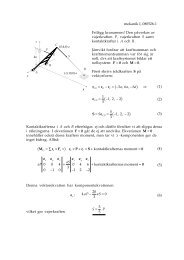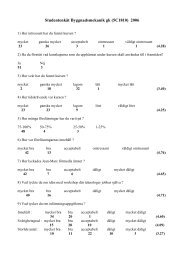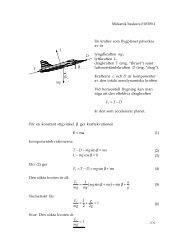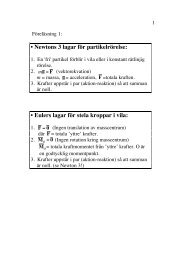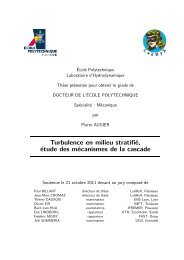Fluid mechanics of fibre suspensions related to papermaking - DiVA
Fluid mechanics of fibre suspensions related to papermaking - DiVA
Fluid mechanics of fibre suspensions related to papermaking - DiVA
Create successful ePaper yourself
Turn your PDF publications into a flip-book with our unique Google optimized e-Paper software.
3.4. PULP SUSPENSIONS 21<br />
is obtained but extensional flow is shown <strong>to</strong> be more efficient in dispersing <strong>fibre</strong><br />
flocs. This was first demonstrated by Kao & Mason (1975) and experimentally<br />
verified by Norman & Duffy (1977). Studies <strong>of</strong> floc rupture in shear flow has<br />
also been made by Lee & Brodkey (1987) and flow rupture in extensional flow<br />
was studied by James et al. (2003). In a work by Blaser (2000) the mechanism<br />
<strong>of</strong> shear and strain on floc motion was presented but not for pulp <strong>suspensions</strong>.<br />
However, the observations are similar <strong>to</strong> what has been reported for pulp suspension<br />
flows.<br />
Soszynski & Kerekes (1988) confirmed the influence <strong>of</strong> bending stresses on<br />
floc strength through stress relaxation experiments. They defined the propensity<br />
for paper-making <strong>fibre</strong>s <strong>to</strong> flocculate in terms <strong>of</strong> a dimensionless number,<br />
termed the crowding number N<br />
N = 2 2<br />
cvr<br />
3<br />
(3.8)<br />
where cv is the volume fraction <strong>of</strong> the solid material in the suspension, and<br />
r is the <strong>fibre</strong> aspect ratio. The physical significance <strong>of</strong> N can be seen in its<br />
definition: N reflects the number <strong>of</strong> <strong>fibre</strong>s in a spherical volume <strong>of</strong> diameter<br />
equal <strong>to</strong> unity. This definition can be <strong>related</strong> <strong>to</strong> the more widely used measure<br />
<strong>of</strong> particle concentration–the number <strong>of</strong> particles per unit volume (n) through<br />
n = 6N/(πl 3 p). Flocculation does not generally occur when N ≪1, as each <strong>fibre</strong><br />
can rotate freely. In the range 1 < N < 60, <strong>fibre</strong>s flocculate in simple shear flow<br />
see e.g. Soszynski & Kerekes (1988). It is in this range that most <strong>papermaking</strong><br />
processes operate. Fibre mobility is greatly hindered when N > 60, as the<br />
suspension forms networks, with each <strong>fibre</strong> making contact with on average<br />
three other closely located <strong>fibre</strong>s, see Meyer & Wahren (1964). The crowding<br />
number was supplemented by a <strong>fibre</strong> Reynolds number and a force fac<strong>to</strong>r in an<br />
overview by Kerekes (1995). The use <strong>of</strong> a crowding number has been further<br />
extended by Kiviranta & Dodson (1995) in characterising the mix conditions<br />
during paper forming.<br />
As previously mentioned, the rheologies <strong>of</strong> pulp <strong>suspensions</strong> are complex<br />
though important, since the interaction <strong>of</strong> the <strong>fibre</strong> suspension and the flow<br />
field results in some very specific characteristics (see Niskanan et al. (1998)<br />
and Björkman (1999)). In pipe flows at low flow velocities, pulp <strong>suspensions</strong><br />
will flow like plug flows. Plug flows characteristically flow has an almost homogenous<br />
velocity pr<strong>of</strong>ile is obtained through most <strong>of</strong> the pipe and close <strong>to</strong><br />
the wall a thin lubricating water layer is observable. As the velocity increases,<br />
the shear at the wall will cause rupturing at the individual <strong>fibre</strong> level or at the<br />
forming floc level, or both. This is referred <strong>to</strong> as turbulence in some cases, however<br />
there is a suggestion that it ought <strong>to</strong> be called fluidised flow (see Söderberg<br />
(1999)). As the velocity increases further, the centre plug flow gradually breaks<br />
up and becomes fluidised.<br />
In turbulence in a New<strong>to</strong>nian fluid, the continuous spectrum <strong>of</strong> scales are<br />
most probably influenced by the presence <strong>of</strong> <strong>fibre</strong>s in the flow. The small eddies,<br />
in order <strong>of</strong> the <strong>fibre</strong> size, are presumably suppressed and the larger eddies are


